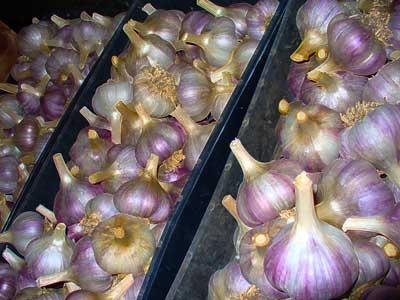Garlic Controls Insects
Gardeners' folklore has always advocated the use of garlic as a pest control. Now science is showing that that those old wives tales are true.
Garlic leaf agglutinin (ASAL) is toxic to sap-sucking pests like cotton and pea aphids, and some caterpillars. ASAL is a lectin related protein that is highly antinutritional and toxic to some insects such as the rice brown plant hopper, green leaf hopper, chickpea aphid, mustard aphid and other hemipteran insects (Mondal et al. 2011). This compound protects garlic plants against many insect pests.
By the way, ASAL is not toxic to mammals since it does not bind to mammalian intestinal gut enzymes (Stadler and Stadler 2003, Mondal et al 2011).
Picture: Is garlic a better insecticide? Trays of Siberian hardneck garlic bulbs after curing.
Zhao et al. (2013) reported that garlic (Allium sativum L.) essential oil had strong insecticidal activity against overwintering pear psyllid adults, Cacopsylla chinensis (Hemiptera: Psyllidae). Pear psyllid suck plant juices and produce honeydew, like aphids. These pests can hinder plant growth and damage terminal buds. In addition, the honeydew can encourage black sooty mold growth on the infested plant. Pear psyllid are also known as 'jumping plantlice' (which may be one of the least appealing nicknames I have heard).
Zhao's research team analyzed garlic oil and found that the two main compounds, diallyl trisulfide (50%) and diallyl disulfide (25%), showed strong acute toxicity against the overwintering pear psyllid (LC50 values were 0.64 µg and 11.04 µg per insect, respectively). LC50 value is the amount that kills 50% of the insects. In contrast, pyrethrum extract has a LC50 value of 1.47 µg per insect. This means that the main oil in garlic, diallyl trisulfide, is twice as toxic to insects as pyrethrum.
Park and Shin (2005) studied the effect of different plant oils on the Japanese termite (Reticulitermes speratus Kolbe). Garlic compounds diallyl trisulfide was the most toxic, followed closely by diallyl disulfide, and diallyl sulfide.
Why garlic kills insects (mechanisms):
Upadhyay and Singh (2012) believe that the lectins or lectin like compounds (ASAL) in garlic may interfere with different aspects of the insect life cycle. Lectins serve as plant defences against insects, viruses, fungi, bacteria and mites (Peumans and Van Damme 1995, Saha et al. 2007, Roy et al. 2008, Chakraborti et al. 2009). These garlic compounds are toxic to many insects and can be a strong deterrent to feeding and egg laying behavior (Michiels et al. 2010). They bind to and damage sensory receptors, midgut receptor proteins, intracellular proteins and other vital proteins within the insects digestive tract.
Some studies strongly suggest that the oils and/or vapors in garlic are directly toxic to insects (Park and Shin 2005, Zhao et al. 2013).
Garlic kills pests cheaply while preserving beneficial insects:
Baidoo and Mochiah (2016) reported that compared to a chemical pesticide, Attack® (Emamectin benzoate), garlic extracts protected cabbages from pest insects while maintaining natural predator populations.
Using garlic was also cheaper. Plots treated with garlic had the highest cost:benefit ratio of 1:16 while plots treated with Attack® recorded the smallest cost:benefit ratio of 1:9.2.
References:
- Baidoo PK & Mochiah MB. Comparing the effectiveness of garlic (Allium sativum L.) and hot pepper (Capsicum frutescens L.) in the management of the major pests of cabbage Brassica oleracea (L.). Sustainable Agriculture Research. 2016;5 Full paper.
- Chakraborti D, Sarkar A, Mondal HA, Das S. Tissue specific expression of Allium sativum leaf agglutinin (ASAL) in important pulse crop chickpea (Cicer arietinumL.) to resist the phloem feeding Aphis craccivora. Transgenic Res. 2009;18:529–544. Pubmed.
- Michiels K, Van Damme EJ, Smagghe G. Plant-insect interactions: what can we learn from plant lectins? Arch Insect Biochem Physiol. 2010;73:193-212. Pubmed. doi: 10.1002/arch.20351
- Mondal HA, Chakraborti D, Majumder P, Roy P, Roy A, Bhattacharya SG, Das S. Allergenicity assessment of Allium sativum leaf agglutinin, a potential candidate protein for developing sap sucking insect resistant food crops. PLoS One. 2011;6:e27716. Pubmed. doi: 10.1371/journal.pone.0027716 (full text)
- Park IK, Shin SC. Fumigant activity of plant essential oils and components from garlic (Allium sativum) and clove bud (Eugenia caryophyllata) oils against the Japanese termite (Reticulitermes speratus Kolbe). J Agric Food Chem. 2005;53:4388-92. Pubmed.
- Peumans WJ, Van Damme EJM. Lectins as plant defense proteins. Plant Physiol. 1995;109:347–352. Pubmed. Full text.
- Roy A, Chakraborti D, Das S. Effectiveness of garlic lectin on red spider mite of tea. J Plant Interact. 2008;3:157–162.
- Saha P, Chakraborti D, Sarkar A, Dutta I, Basu D, Das S. Characterization of vascular-specific RSs1 and rolC promoters for their utilization in engineering plants to develop resistance against hemipteran insect pests. Planta. 2007;226:429–442. Pubmed.
- Stadler MB, Stadler BM. Allergenicity prediction by protein sequence. FASEB J. 2003;17:1141–1143. Pubmed.
- Upadhyay SK, Singh PK. Receptors of garlic (Allium sativum) lectins and their role in insecticidal action. Protein J. 2012;31:439-46. Pubmed. doi: 10.1007/s10930-012-9423-8
- Upadhyay SK1, Singh S, Chandrashekar K, Tuli R, Singh PK. Compatibility of garlic (Allium sativum L.) leaf agglutinin and Cry1Ac δ-endotoxin for gene pyramiding. Appl Microbiol Biotechnol. 2012;93:2365-75. Pubmed. doi: 10.1007/s00253-011-3547-1
- Zhao NN, Zhang H, Zhang XC, Luan XB, Zhou C, Liu QZ, Shi WP, Liu ZL. Evaluation of acute toxicity of essential oil of garlic (Allium sativum) and its selected major constituent compounds against overwintering Cacopsylla chinensis (Hemiptera: Psyllidae). J Econ Entomol. 2013;106:1349-54. Pubmed.
